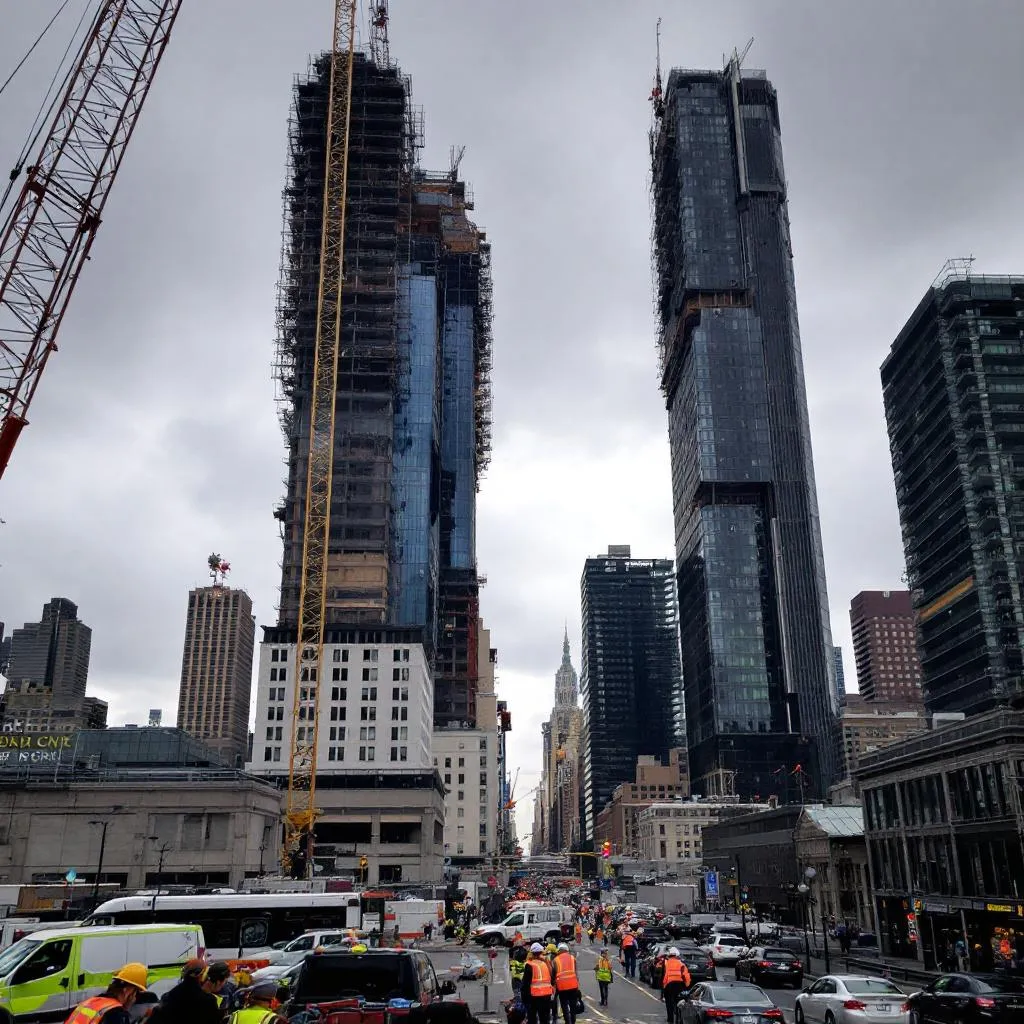Why Construction ERP is Essential for New York Businesses: Boosting Efficiencies, Cutting Costs, and Harnessing Single Database Platforms
New York City’s skyline is a testament to human ambition, with towering skyscrapers like One Vanderbilt and ongoing mega-projects such as the Hudson Yards redevelopment defining the landscape. Yet, behind these feats lies a construction industry grappling with skyrocketing costs, stringent regulations, and relentless deadlines. In this high-stakes environment, Construction Enterprise Resource Planning (ERP) systems aren’t just helpful—they’re indispensable. These integrated platforms unify project management, financial tracking, and operations, helping firms navigate the unique challenges of building in the Empire State. As New York’s construction spending is forecasted to rise modestly by 0.4% in 2025 before surging 14.9% to $22.1 billion in 2026, adopting ERP could mean the difference between thriving and merely surviving. This article explores why ERP is essential for New York’s construction sector, the operational and financial benefits, and which platforms lead the industry.
The Vital Role of Construction ERP in New York’s Construction Landscape
In a city where every square foot comes at a premium and projects often involve navigating dense urban grids, historic preservation rules, and union labor agreements, traditional management tools fall short. Spreadsheets and siloed software lead to miscommunications, permit delays, and budget overruns—issues amplified by New York’s complex ecosystem of stakeholders, from the Department of Buildings (DOB) to environmental regulators. Construction ERP serves as a centralized command center, integrating bidding, scheduling, compliance, procurement, and payroll. With labor shortages affecting over 75% of NY construction firms, ERP ensures optimal workforce planning across projects ranging from Brooklyn’s Navy Yard to Manhattan’s high-rises.
Real-time decision-making is a major ERP advantage. Project managers can track progress on subway extensions or bridge overhauls and spot potential delays before they escalate. ERP systems also streamline compliance with Local Law 147, which mandates detailed safety documentation for permits. Automatic tracking and alerts reduce penalties and prepare firms for audits, including those related to contractor registration or environmental standards.
Driving Operational Efficiencies in NY’s Fast-Paced Projects
Efficiency is not optional in New York construction—it’s a survival strategy. From winter storms and traffic congestion to limited staging space, construction projects face significant logistical hurdles. ERP tools automate routine tasks like ordering materials, processing payroll, or updating project schedules. Mobile apps bridge communication between field and office staff in real-time, helping avoid costly rework and communication gaps.
ERP platforms also support collaboration in complex projects involving multiple contractors. Shared dashboards promote transparency, while forecasting tools detect supply chain issues or labor shortfalls. These features collectively improve productivity by up to 30%, a game-changer for time-sensitive projects like the Gateway Tunnel or the Second Avenue Subway extension.
Achieving Substantial Cost Savings Amid NY’s High Expenses
Construction costs in NYC are among the highest in the U.S., driven by expensive land, labor unions, and tight regulations. ERP systems improve cost efficiency by optimizing procurement, minimizing material waste, and preventing duplicate orders. Bulk purchasing and precise forecasting help control budgets and avoid price escalations on materials like steel or concrete.
ERP also boosts financial performance through streamlined billing and faster collections, critical for subcontractors facing thin margins. While ERP implementation can disrupt operations during rollout, success stories like the New York City School Construction Authority demonstrate how careful planning and stakeholder engagement lead to long-term gains. Cost savings of 5-10% in project margins are common once systems are fully integrated.
The Power of a Single Database Platform in NY Construction ERP
One of ERP’s greatest strengths is its unified database architecture. Instead of juggling disconnected tools for budgeting, scheduling, and reporting, firms operate from a single source of truth. This reduces data duplication, enhances coordination, and shortens response times across departments. For example, unified data helps align subcontractor schedules on multi-phase developments like Queens’ Hunters Point South.
Analytics also thrive in a centralized platform. Firms can monitor labor cost trends, safety violations, or equipment usage patterns, enabling smarter bidding and workforce planning. A single system reduces IT maintenance overhead and simplifies user training—crucial advantages in a city where firms juggle dozens of projects simultaneously.
Leading Construction ERP Software Companies for New York Firms
- CMiC Global: Offers a robust Single Database Platform™ tailored to construction. Used by Iovino Enterprises, it streamlines accounts payable, forecasting, and job costing, ideal for infrastructure-heavy NY markets.
- Acumatica: A cloud-native ERP with flexible dashboards, real-time project tracking, and scalability for contractors of all sizes. Favored by subcontractors in borough-wide commercial builds.
- NetSuite: Known for its full-suite capabilities and real-time visibility. Its CRM integration helps NY firms win competitive bids and maintain strong client relationships.
- Sage 300 Construction and Real Estate: Integrates accounting, operations, and project management. Suitable for mid-sized contractors navigating NY’s regulatory-heavy environment.
- Procore: A construction management favorite, particularly for its mobile usability on NY job sites. Used for budgeting, scheduling, and communication in real-time.
- Microsoft Dynamics 365 Business Central: Offers integrated tools for financials, HR, and resource planning. Popular with NY firms seeking seamless Microsoft Office integration.
Case Studies: ERP Success in New York Construction
The New York City School Construction Authority (SCA) adopted ERP to manage one of the largest public school building programs in the U.S. By consolidating project data and automating reporting, SCA improved compliance and project delivery timeframes. Similarly, CMiC helped Iovino Enterprises automate time-consuming accounting tasks, saving hours weekly and improving executive decision-making on regional infrastructure projects.
Frequently Asked Questions (FAQ)
What makes Construction ERP particularly important for New York businesses?
In NY, ERP addresses unique hurdles like high costs, strict DOB regulations, and urban logistics, providing tools for compliance, real-time monitoring, and efficient resource use amid labor shortages.
How does Construction ERP improve efficiencies in NY projects?
By automating workflows, enabling field-office collaboration, and predicting delays, ERP boosts productivity by 20-30%, crucial for timely completions in weather-prone, high-density areas.
What cost savings can NY construction firms expect from ERP?
Savings of 5-10% on margins through optimized procurement, error reduction, and better cash flow, helping offset NY’s premium expenses in materials and labor.
Why is a single database platform key for NY construction ERP?
It ensures data consistency across complex projects, supports analytics for regulatory compliance, and reduces silos, leading to faster decisions and lower IT costs.
Which ERP software is best suited for New York construction companies?
Top choices include CMiC Global for its integrated platform, NetSuite for comprehensive views, and Procore for mobile efficiency, with proven success in NY environments.
How does ERP help with New York’s construction regulations?
ERP automates documentation for laws like Local Law 147 and contractor registrations, ensuring audits are seamless and penalties avoided.
What challenges do NY firms face in adopting ERP, and how to overcome them?
Common issues include resistance to change and data migration; solutions involve tailored training and phased implementations, as seen in successful NY case studies.
Key Considerations for Construction ERP in New York: A Summary Chart
| Key Consideration | Description | NY-Specific Benefits | Potential Challenges |
|---|---|---|---|
| Efficiency Improvements | Automation of scheduling, invoicing, and reporting | 20-30% productivity gains; better handling of urban delays and labor shortages | Initial training for union workers |
| Cost Savings | Resource optimization, waste reduction, accurate forecasting | 5-10% margin boosts amid high NY costs; improved cash flow for subcontractors | Upfront implementation expenses |
| Single Database Platform | Unified data for all operations | Real-time insights for compliance with DOB and safety laws; reduced errors in multi-stakeholder projects | Data migration complexities |
| Regulatory Compliance | Automated tracking and reporting | Easier adherence to Local Law 147, contractor registrations, and wage laws | Keeping up with evolving NY rules |
| Software Selection | Industry-specific, scalable ERPs | Tailored for NY’s high-rises and infrastructure; integration with local tools | Evaluating fit for diverse project types |
| Implementation Strategy | Phased rollout with training | Minimizes disruptions in fast-paced NY market; leverages case studies like SCA’s ERP | Resistance to change in established firms |
Author: STAFF HERE NEW YORK WRITER
The NEW YORK STAFF WRITER represents the experienced team at HERENewYork.com, your go-to source for actionable local news and information in New York, the five boroughs, and beyond. Specializing in "news you can use," we cover essential topics like product reviews for personal and business needs, local business directories, politics, real estate trends, neighborhood insights, and state news affecting the area—with deep expertise drawn from years of dedicated reporting and strong community input, including local press releases and business updates. We deliver top reporting on high-value events such as New York Fashion Week, Macy's Thanksgiving Day Parade, and Tribeca Film Festival. Our coverage extends to key organizations like the Greater New York Chamber of Commerce and United Way of New York, plus leading businesses in finance and media that power the local economy such as JPMorgan Chase, Goldman Sachs, and Bloomberg. As part of the broader HERE network, including HEREBuffalo.com, we provide comprehensive, credible insights into New York's dynamic landscape.





